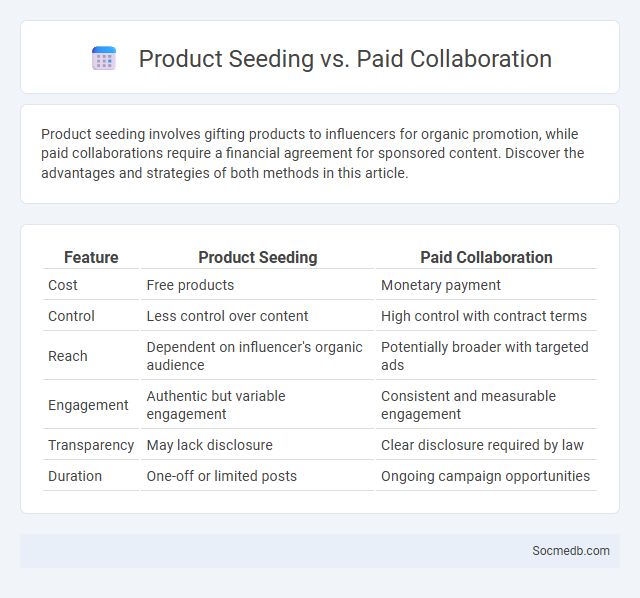
Photo illustration: Product Seeding vs Paid Collaboration
Product seeding involves gifting products to influencers for organic promotion, while paid collaborations require a financial agreement for sponsored content. Discover the advantages and strategies of both methods in this article.
Table of Comparison
| Feature | Product Seeding | Paid Collaboration |
|---|---|---|
| Cost | Free products | Monetary payment |
| Control | Less control over content | High control with contract terms |
| Reach | Dependent on influencer's organic audience | Potentially broader with targeted ads |
| Engagement | Authentic but variable engagement | Consistent and measurable engagement |
| Transparency | May lack disclosure | Clear disclosure required by law |
| Duration | One-off or limited posts | Ongoing campaign opportunities |
Introduction: Understanding Influencer Marketing Approaches
Influencer marketing approaches leverage social media platforms to connect brands with targeted audiences through trusted content creators. By analyzing engagement metrics and audience demographics, you can select influencers whose followers align with your brand values and marketing goals. This strategy maximizes reach and authenticity, driving higher conversion rates and brand loyalty.
What is Product Seeding?
Product seeding is a strategic marketing technique where brands distribute free products to influencers or potential customers to generate authentic content and word-of-mouth promotion on social media platforms. This approach leverages the audience trust and engagement of influencers to increase brand visibility and drive organic reach. By targeting niche communities, product seeding enhances product credibility and fosters genuine conversations around the brand.
What is Paid Collaboration?
Paid collaboration on social media involves a partnership where brands compensate influencers or content creators to promote products or services, ensuring authentic engagement with targeted audiences. This strategic marketing approach leverages trust between creators and followers, maximizing reach and conversion rates through sponsored posts, stories, or videos. Understanding paid collaboration helps you optimize your brand visibility and achieve measurable ROI through influencer marketing campaigns.
Defining Influencer Partnerships
Influencer partnerships involve collaboration between your brand and social media personalities who have established trust and credibility with their audience. By leveraging influencers' reach and engagement on platforms like Instagram, TikTok, and YouTube, your brand can effectively target specific demographics and enhance authentic connections. Clear definition of partnership goals and audience alignment maximizes the impact of influencer marketing campaigns.
Key Differences: Product Seeding vs Paid Collaboration
Product seeding involves sending free products to influencers or users to generate organic promotion and authentic reviews, enhancing brand credibility without direct payment. Paid collaboration requires a formal agreement where influencers create specified content in exchange for monetary compensation, ensuring controlled messaging and measurable reach. Understanding these key differences helps you optimize marketing strategies for budget efficiency and audience engagement.
Pros and Cons of Product Seeding
Product seeding leverages social media's reach to introduce new products directly to influencers or target audiences, boosting brand visibility and fostering authentic engagement. Your campaign can rapidly gain momentum from organic shares and user-generated content, but the approach risks inconsistent brand representation and potential negative feedback if the product fails to meet expectations. Careful selection of influencer partners and clear communication are essential to maximize benefits while minimizing reputational risks.
Pros and Cons of Paid Collaboration
Paid collaboration on social media offers targeted reach and enhanced brand visibility, leveraging influencer credibility to boost engagement and sales effectively. Your campaigns can gain precise audience segmentation and measurable ROI, but risks include potential audience distrust and high costs that may not always guarantee proportional returns. Balancing authentic content with sponsored messages is crucial to maintain follower trust and long-term success.
Choosing the Right Strategy for Your Brand
Selecting the ideal social media strategy for your brand involves analyzing target audience demographics, platform trends, and competitor performance to ensure maximum engagement and reach. Leveraging data-driven insights from tools like Google Analytics and social media analytics platforms enables precise content customization and optimal posting schedules. Investing in consistent branding and authentic interaction enhances follower loyalty and drives measurable business growth across channels such as Instagram, LinkedIn, and TikTok.
Measuring ROI: Product Seeding vs Paid Collaborations
Measuring ROI in social media marketing requires a clear comparison between product seeding and paid collaborations. Product seeding often yields organic engagement and brand advocacy with lower immediate costs, while paid collaborations provide precise targeting and measurable metrics via analytics platforms. To maximize Your marketing budget, analyze conversion rates, audience reach, and engagement quality from both strategies using tools like Google Analytics and social media insights.
Best Practices for Successful Influencer Campaigns
Identify influencers whose audience aligns closely with your target market to maximize campaign relevance and engagement. Develop authentic content strategies that encourage genuine interaction, leveraging storytelling to enhance brand trust and visibility. Monitor campaign performance using key metrics such as engagement rates, reach, and conversion to refine tactics and optimize return on investment.
 socmedb.com
socmedb.com